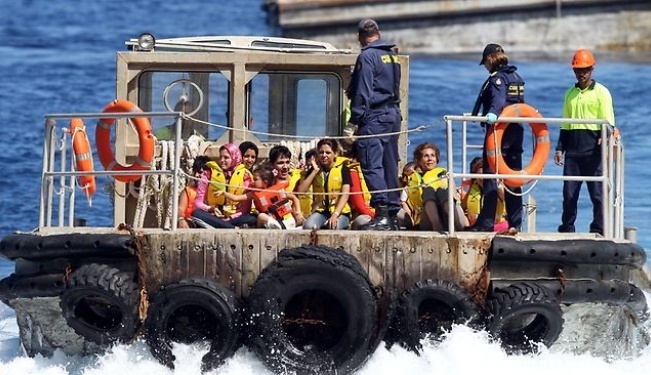An overview of Australia’s humanitarian policy and politics.
Political rhetoric and media reports suggest that ‘boat people’ are a key issue of concern for the world’s largest island nation, Australia. Three issues dominated political debate in the lead up to the last federal election in August 2010: climate change, mental health and ‘boat people’. Disturbing events, such as the sinking of an asylum seeker boat off the coast of Christmas Island in December 2010, and controversial policy announcements such as that of the ‘Malaysia solution’ by the incumbent Labor Government in May 2011, have ensured that ‘boat people’ remain particularly high on the political agenda.
Most Australians have strong views on the asylum-seeker issue, but many seem to give preference to political rhetoric over facts. This article does not attempt to cover all related issues, but aims to take a step back to put key aspects of the ‘boat people’ debate into relevant historic and global contexts.
Defining a ‘Boat Person’
The term ‘boat person’ is popular in the Australian vernacular, yet it has no legal power. Nevertheless, it may be said that ‘boat people’ are asylum seekers who reach Australia’s shores by boat without having previously been granted a visa to enter the country. The Australian Department of Immigration and Citizenship refers to individuals in this situation as Irregular Maritime Arrivals, or IMAs.
It is internationally accepted that asylum seekers are people seeking protection outside of their own country and whose claims for refugee status have not yet been assessed. For an individual to be considered a refugee, they must meet the criteria set out under the Convention Relating to the Status of Refugees 1951 (Refugee Convention), which Australia acceded to in early 1954. Article 1 of the Refugee Convention requires a refugee to be outside of their own country and to have a “well-founded fear of being persecuted for reasons of race, religion, nationality, membership of a particular social group or political opinion.” Other possible reasons for fear of persecution are not legally covered by the Convention. However, recognising possible gaps in the Refugee Convention of 1951, many countries have enacted complementary protection legislation. Australia has only recently taken steps towards the possible introduction of such legislation.
As a signatory to the 1951 Refugee Convention, Australia has an obligation to permit entry without prior authorisation to people seeking asylum. It is interesting to note that public debate in Australia typically focuses on asylum seekers who arrive by boat. Limited attention is given to asylum seekers who enter the country by air on a valid visa, such as a tourist or student visa, and to internationally recognised refugees who are resettled in Australia. In contrast, boat arrivals are commonly labelled ‘illegal immigrants’ or ‘queue jumpers’. This unfounded bias suggests both a misleading interpretation of the facts for political gains and a limited awareness amongst the general population of the larger context.
Australia’s Humanitarian Tradition
Contrary to popular belief, Australia’s experience with asylum seekers, and especially ‘boat people’, is not new. Various academics and policy advisors have found it useful to distinguish between three key waves of Australian boat arrivals. The first of these waves dates back to the aftermath of the Vietnam War. From mid 1976 until mid 1981, just over 2,000 Vietnamese boat arrivals reached Australian shores. The second wave began in late 1989 and saw a total of about 3,100 ‘boat people’ arrive by 1998, predominately of Cambodian, Vietnamese, and southern Chinese origin. The third wave from 1999 to 2001 brought nearly 12,200 people, the majority of whom were Afghan or Iraqi nationals. Many believe that a change in government in 2007, and the subsequent revoking of certain hardline and internationally criticised asylum seeker policies, provoked the present, fourth wave of ‘boat people’.
Taking a step back from the current focus on boat arrivals not only reveals the recurring nature, but also the overall significance of the humanitarian phenomenon for Australia. Immigration statistics indicate that since the end of World War II, over 750,000 humanitarian entrants have been settled in Australia. This figure represents about one-tenth of the overall immigration intake and one-twentieth of the nation’s population growth during the corresponding period. It is an impressive statistic, one which many Australians are proud of. However, like any statistic, it must be put into context, which includes the fact that a significant proportion of Australia’s refugee intake may be traced back to the immediate aftermath of World War II. Around 170,000 displaced Eastern Europeans were resettled in Australia between 1947 and 1954. Thousands more refugees followed from European crises during the Cold War. Since the end of the Vietnam War in 1975, 150,000 Indochinese refugees have made up another particularly large proportion of the total number of humanitarian entrants.
On a global scale, the United Nations High Commissioner for Refugees (UNHCR) has estimated that at the end of 2010 there were around 43.7 million forcibly displaced people in the world. This figure includes asylum seekers, recognised refugees, and internally displaced persons (IDPs). UNHCR estimated that there will be a need for resettlement of about 172,000 persons in 2011. Yet, this key refugee agency currently has a mere 80,000 resettlement places per year promised by willing member states. In 2010, developing nations hosted about 80% of the world’s refugees, many of whom had fled neighbouring countries. Statistics compiled by UNHCR show that in late 2010 Australia hosted almost 22,000 refugees. This figure ranks Australia 46th globally by the number of refugees it hosts and indicates that the country hosts a mere 0.2 % of the global total. The overall ‘ranking’ drops significantly if the total number of refugees hosted is considered in comparison to either country population size (69th) or GDP per capita (79th).
Current Humanitarian Policy
Australian migration policy in general, and especially asylum seeker policy, has been the subject of debate for much of the country’s modern history. It might reasonably be said that each new government has attempted to tackle the issue in a very different manner. A general progression from ad hoc responses to individual international events, to a long-term, planned program can be identified. However, the specifics of this program have, in the course of the last two decades, included controversial approaches as diverse as mandatory detention for unauthorised boat arrivals, the excision of offshore territories from Australia’s migration zone, and the introduction of temporary protection visas.
Reflective of practices in many developed countries, the Australian humanitarian program is managed separately from the country’s regular migration program. The current humanitarian program has both onshore and offshore components. Individuals who enter Australia’s migration zone, by plane or boat, may lodge protection claims that are processed onshore. Australia grants different visas under the offshore component. This includes refugee and ‘woman at risk’ visas for individuals living outside of their home country who have been referred for resettlement by UNHCR. It also includes the ‘special humanitarian program’ for individuals subject to persecution that are proposed by an Australian citizen, permanent resident, or organisation. Places are limited in this program and priority is given to the reunion of immediate family members.
A significant aspect of Australia’s humanitarian program is that the onshore and offshore components are numerically linked. Australia’s current, predetermined humanitarian intake is set at 13,750 individuals per year. In the program year 2010-11, 6,000 of these places were reserved for UNHCR referred refugees. The remaining 7,750 places were then divided between onshore protection claims and the offshore ‘special humanitarian program’, with the former effectively given preference over the latter.
Key Statistics In Context
Australian immigration statistics, including those relating to humanitarian entrants, are plentiful. As an island nation, with a limited number of international airports, Australia has been able to track international people movements more easily and more accurately than most countries with land borders, including the USA and most European states. In addition, Australian governments have usually been very willing to share collected immigration data with the general public. Unfortunately, however, the mere availability of relatively accurate statistics does not shield them from misinterpretation.
Australia began specifically recording the arrival of ‘boat people’ in 1976. Since that time numbers have fluctuated greatly, with anywhere between zero and almost 6,000 such arrivals recorded in any program year (1 July through 30 June). Minor adjustments have been made in the way boat arrivals have been counted, whilst boats intercepted and turned back before they reached Australian waters have generally not been counted. A peak in the number of Australian boat arrivals was witnessed in the period from 1999 to 2001, with around 4,100 arrivals recorded in each program year. From 2002 to 2008 the recorded number of boat arrivals dropped considerably. Since 2009 numbers have again risen, which is largely attributed to a strengthening of the regional people smuggling system. Over 1,000 boat arrivals were recorded in 2008-09, about 5,600 in 2009-10, and close to 5,000 in 2010-11.
Recently, the Australian public has been made to believe that the number of ‘boat people’ that successfully reach Australia’s shores is alarmingly high. However, such scare tactics ignore the larger picture. On a national level, immigration statistics show that boat arrivals have consistently made up less than half the total number of protection claims lodged onshore. That is, in any given program year, more asylum seekers arrived by plane than by boat. In 2008-09 only 16%of all asylum seeker applicants arrived by sea, while in 2009-10 this figure rose to 47%. In addition, immigration statistics reveal that boat arrivals are more likely to be assessed as refugees than plane arrivals. When both primary and subsequent independent review decisions are considered, the final protection visa grant rate for Afghan nationals arriving by boat in 2009-10 was 99.7 %. The final grant rates for other key ethnicities likely to seek asylum by boat, including people from Iraq, Iran and Burma, were between 96 and 98 %. In contrast, only 20 to 30 % of protection visa applications lodged by air arrivals, have been successful in any given program year.
Australia’s experience with asylum seekers should also be compared to that of other countries. The Organisation for Economic Cooperation and Development (OECD) has found that Australia’s share of asylum applications is very small compared to that of most other OECD member countries. OECD statistics for the last decade also reveal that fluctuations in Australian statistics reflect trends experienced across much of the OECD. In addition, statistics compiled by many different organisations have all found that more asylum claims are lodged in Europe than in any other region, namely between 250,000 and 300,000 per year. The UNHCR receives humanitarian statistics from 44 industrialised countries and found that in 2010 the USA received the largest number of new asylum claims (55,500) amongst this group. France was second with 47,800 asylum seeker claims, followed by Germany, Sweden and Canada. With just over 8,000 claims in the same period, Australia therefore only received a small fraction. This is despite an increase of 31 % from 2009 to 2010 in the number of asylum seeker claims lodged in Australia and New Zealand.
The Way Forward
No one can reliably predict what the future direction of Australia’s policies concerning ‘boat people’ might be. Current and past politicians alike have suggested that they have little scruple about significantly changing their viewpoint on the issue and their preferred approaches to address it. In addition, Australian leaders seem willing to ignore expectations of the international community for domestic political gains. Issues surrounding ‘boat people’ and other humanitarian entrants are unlikely to disappear from the political agenda, given their complexity as well as their strong ability to provoke both hostile and compassionate reactions from voters. Australia has the potential to take a leading role in responding to global humanitarian issues by focusing more on refugee resettlement and less on excessive border control. However, it has yet to rise to the challenge.
Support Fair Observer
We rely on your support for our independence, diversity and quality.
For more than 10 years, Fair Observer has been free, fair and independent. No billionaire owns us, no advertisers control us. We are a reader-supported nonprofit. Unlike many other publications, we keep our content free for readers regardless of where they live or whether they can afford to pay. We have no paywalls and no ads.
In the post-truth era of fake news, echo chambers and filter bubbles, we publish a plurality of perspectives from around the world. Anyone can publish with us, but everyone goes through a rigorous editorial process. So, you get fact-checked, well-reasoned content instead of noise.
We publish 2,500+ voices from 90+ countries. We also conduct education and training programs
on subjects ranging from digital media and journalism to writing and critical thinking. This
doesn’t come cheap. Servers, editors, trainers and web developers cost
money.
Please consider supporting us on a regular basis as a recurring donor or a
sustaining member.
Will you support FO’s journalism?
We rely on your support for our independence, diversity and quality.







Comment